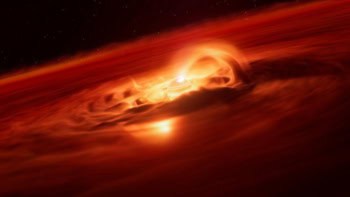
After a five-year journey to Jupiter, travelling some 3.2 billion kilometres, NASA’s Juno craft has finally arrived at the largest planet in our solar system. Having sped towards Jupiter at more than 25,750 kph, JUNO fired its braking rocket yesterday at 11:18 p.m. EDT for 35 minutes, so that it could be captured by Jupiter’s gravity. JUNO has now entered a highly elliptical orbit around the poles of the planet – taking it within 4800 km of the planet’s atmosphere – and will now spend more than a year taking data to understand how the planet formed and whether it has a rocky core.
“The spacecraft worked perfectly, which is always nice when you’re driving a vehicle with 1.7 billion miles on the odometer,” says Rick Nybakken, Juno project manager from the Jet Propulsion Laboratory. “Jupiter orbit insertion was a big step and the most challenging remaining in our mission plan, but there are others that have to occur before we can give the science team the mission they are looking for.”
A lot to see and do
Scott Bolton, principal investigator of Juno from the Southwest Research Institute in San Antonio, adds: “Our official science-collection phase begins in October, but we’ve figured out a way to collect data a lot earlier than that. Which when you’re talking about the single biggest planetary body in the solar system, is a really good thing. There is a lot to see and do here.”
Mission scientists hope that Juno will help them to understand how Jupiter formed and evolved and what hides beneath the planet’s clouds. Jupiter’s composition is dominated by hydrogen and helium, but its atmosphere also contains heavier elements including carbon, nitrogen and oxygen. However, astronomers do not know how this thick, hot atmosphere is structured or how much water it contains.
JUNO will also map Jupiter’s magnetic field in unprecedented detail, possibly revealing details about its origin. Jupiter’s magnetic field is around 10 times stronger than Earth’s, producing the largest magnetosphere of any planet in the solar system, extending some three million kilometres. “One of the reasons that the Juno mission is so exciting is because we can map Jupiter’s magnetic field without having to look through the crustal magnetic fields, which behave like a jumble of refrigerator magnets,” says Jack Connerney, deputy principal investigator and head of the magnetometer team at NASA’s Space Goddard Flight Center.
A destructive end
Named after the wife of the Roman god Jupiter, Juno is the second probe to orbit Jupiter. The first was NASA’s Galileo satellite, which launched in 1989, and spent eight years circling the planet’s equator (rather than its poles) and studying the Jovian moons. Yet Galileo suffered technical problems – its antenna did not fully open – which meant that the mission could not send back as much data as scientists had anticipated.
Juno will study Jupiter using nine on-board instruments, including a particle detector, camera, magnetometer, microwave radiometer and spectrometer. To protect the instruments from the intensity of radiation surrounding Jupiter, they are housed in a protective vault with centimetre-thick titanium walls.
Juno is powered by three 9 m arms that hold 19,000 solar cells. In January it set the record for the furthest distance a solar-powered probe has travelled in the solar system, breaking a record set by the European Space Agency’s Rosetta spacecraft.
Once Juno has carried out its mission, the probe will be sent crashing into the planet – as the Galileo probe did – to stop it contaminating Jupiter’s ocean-bearing moon, Europa.
There is much more about the Juno mission in the July issue of Physics World: “Brave new Jupiter”.



